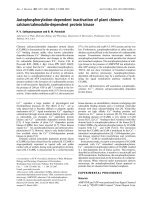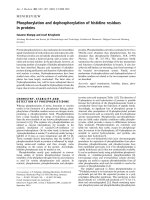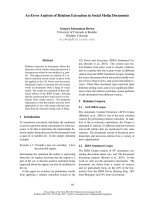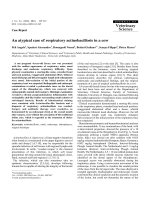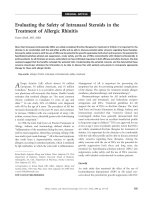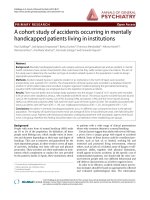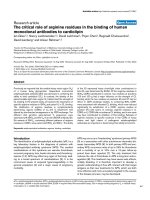Báo cáo y học: "An ethnobotanical survey of medicinal plants in Babungo, Northwest Region, Cameroo" docx
Bạn đang xem bản rút gọn của tài liệu. Xem và tải ngay bản đầy đủ của tài liệu tại đây (286.58 KB, 7 trang )
RESEARC H Open Access
An ethnobotanical survey of medicinal plants in
Babungo, Northwest Region, Cameroon
David J Simbo
Abstract
Background: An ethnobotanical survey was undertaken to record information on medicinal plants from traditional
medical practitioners in Babungo and to identify the medicinal plants used for treating diseases.
Methods: Traditional Medical Practitioners (TMP’s) who were the main informants were interviewed using semi-
structured questionnaires and open-ended conversations. Field trips were made to the sites where TMP’s harvest
plants.
Results: The survey identified and recorded 107 plants species from 54 plant families, 98 genera used for treating
diseases in Babungo. The Asteraceae was the most represented plant family while herbs made up 57% of the total
medicinal plants used. The leaf was the most commonly used plant part while concoction and decoction were the
most common method of traditional drug preparation. Most medicinal plants (72%) are harvested from the wild
and 45% of these have other non medicinal uses. Knowledge of the use of plants as medicines remains mostly
with the older generation with few youth showing an interest.
Conclusions: A divers number of plants species are used for treating different diseases in Babungo. In addition to
their use as medicines, a large number of plants have other non medicinal uses. The youth should be encouraged
to learn the traditional medicinal knowledge to preserve it from being lost with the older generation.
Background
Ethnobotany is the study of how modern and indigen-
ous societies view and use plants [1]. The use of natural
products with healing properties is as old as human civi-
lization and for a long time, minerals, animal and plant
products were the main sources of drugs [2]. The
World Health Organization (WHO) defines traditional
medicine as practices, knowledge and belief systems
which uses minerals , plants and animal based remedies,
spiritual therapies and exercises to prevent, treat and
maintain well being [3]. According to the WHO, about
80% of the population of the world depends on tradi-
tional medicine, mostly herbal remedies, for their pri-
mary health care needs [4]. The African continent have
a long history with the u se of plants and in some Afri-
can countries, up to 90% of the population rely on med-
icinal plants as a source of drugs [5]. A medicinal plant
is any plant, which in one or more of its organs contains
active ingredients which can be used for therapeutic
purposes or contain foundation compounds that can be
used for the synthesis of useful drugs [6]. The absence
or inaccessibility of modern healthcare services, afford-
ability, cultural acceptance and, under certain circum-
stances, effectiveness than their modern counterparts
has caused a large percentage of the population to rely
mostly on plant based traditional medicines for their
primary health care needs. These factors and a growing
interest in the use of natural products and folk medicine
have resulted to an increase i n the demand for medic-
inal plants [7]. This increase in demand puts a threat on
natural resources. Knowledge on the use of medicinal
plants is enormous but if this is not rapidly researched
and recorded, indications are that it will be lost with
succeeding generations [5].
An estimated 25% of prescription drugs and 11% of
drugs considered essential by the WHO are derived
from plants and a large number of synthetic drugs are
obtained from precursor compounds originating from
plants [2]. Therefore the documentation of the tradi-
tional therapeutic know-how could lead to the discovery
of new drugs as well as contribute to the conservation,
Correspondence:
Department of Bioscience Engineering Faculty of Science, University of
Antwerp Groenenborgerlaan 171 2020 Antwerp, Belgium
Simbo Journal of Ethnobiology and Ethnomedicine 2010, 6:8
/>JOURNAL OF ETHNOBIOLOGY
AND ETHNOMEDICINE
© 2010 Simbo; licensee BioMed Centr al Ltd. This is an Open Access article distributed under the terms of the Creative Commons
Attribution License ( es/by/2.0), which permits unrestricted use, distribution, and reproduction in
any medium, provided the original work is properly cited.
sustainable management and use of plant resource s.
Ethnobotanical investigations have been reported for
parts of Cameroon [8-10] and parts of the adjacent
Bamenda highlands [11] but no investigation has ever
been carried out in Babungo. It is therefore necessary to
carry out a survey to document the plants used for med-
icinal purposes in Babungo.
Methods
Study site
The study was carried out in Babungo, located in the
Ngoketunjia division of the Northwest Region of the
Republic of Cameroon. Babungo falls between latitude
6° 01’ and 6° 11’ N and between longitudes 10° 20’ and
10° 29’ E [ 12] as shown in figure 1. The so il type is
sandyclayferruginoussoiland the average altitude is
1200 m above sea level [13]. Ther e are two seasons; the
dry season from November to March and the rainy sea-
son from April to October. Annual prec ipitation is 2300
mm. Situated in the Sudan savannah, it is mostly cov-
ered with Helictotrichon maitlandii C.E Hubbard,
Andropogon gayanus Kunth a nd Pennisetum purpureum
[13]. Com mon tree species include Cola spp., Spathodea
campanulata P. Beauv., Markhamia lutea (Benth)
K. Schum., Canarium schweinfurthii Engl. and Elaeis
guinensis Jacq [12]. The population, of about 14,000
inhabitants, are mostly peasant farmers who grow
corn for subsistence and rice and coffee as cash crops.
Blacksmithing and wood carving are also common
occupations.
Data collection
Traditional Medical Practitioners (TMP’s) were the main
informants in the survey. They were identified with the
help of the t raditional ruler and some of th e elders of
the tribe. A total of 17 TMP’s were interviewed amongst
whom 7 were literate. Their a ges range from 28 to 70
years with more of them in the older side of the range.
Most of the informants were men with only 4 females.
After seeking their consent, the traditional medical prac-
titioners were interviewed using semi-structure ques-
tionnaires and open-ended conversations. Trips were
made to the sites where TMP’s normally go to harvest
plants and during such trips, there were discussions
with the TMP’s in addition to the interviews using the
semi-structure questionnaires. The interviews and dis-
cussions were carried out in the local language since the
author is a native s peaker of the language. Data on the
local names of the plants, the plant parts used, diseases
treated by the plants, mode of usage and administration
were collected in the field. Heal th conditions which
were not recognized by the author were identified by
the health professional at t he health centre in Babungo.
Plants recorded in the results were mentioned by at
least two TMP’s as treating the same disease in order to
confirm its use. Fertile specimens of the plants were col-
lected in the field using standard b otanic methods [14]
together with the TMP’s. The c ollected specimens were
identifie d at the Nationa l Herbarium i n Yaoundé,
Cameroon and voucher specimens were deposited at the
herbarium of the Limbe Botanic Garden, Cameroon.
Results
A total of 107 medicinal plant species from 98 genera
and 54 families used for treating about 55 health pro-
blems were identified in the survey (see additional file
1). The most represented plant family in the list of med-
icinal plants is the Asteraceae with 12.1% of the medic-
inal plants species followed by Lamiaceae and Poaceae
with 5.6% each.
Herbs made up 57% of the total number of medicinal
plants followed by trees (24%), shrubs (15%), and clim-
bers making up the remainin g 4%. The leaves were the
most commonly used plant part followed by the aerial
parts of herbs (8%) and then by the bark (7%) of woody
plants. The roots (6%), the flowers (5%), the fruits (4%)
Figure 1 Location of Babungo in Cameroon [29].
Simbo Journal of Ethnobiology and Ethnomedicine 2010, 6:8
/>Page 2 of 7
and latex (4%) are also used medicinally while the whole
plant is the least used (3%).
Many plants (51.4%) have multiple medicinal uses and
many diseases are treated using a combination of more
than one plant (Additional file 1). For example venereal
diseases are treated by oral administration of a concoc-
tion of the roots of Capsicum frustescens, Vernonia
amygdalina,C.schweinfurthiiand the bracts of Musa
paradis ciaca. For some species, the same part is used to
treat different diseases. For example the leaves of Carica
papaya are used for treating malaria and gastritis.
C. papaya, Eucalyptus spp., Mangifera indica an d Psi-
dium guajava do not have names in the local language
and so t heir English names are used. Some plants from
the Asteraceae family (Ageratum conyzoides, C rassoce-
phalum rubens, Dichrocephalla integrifolia, Erygerum
floribundus and Vernonia calvoana) are commonly called
ndobovensi which translates to the devil’s cigarette.
Decoctions were the most common method of pre-
paration and most of the medicines are administered
orally with topical administration in the case of skin dis-
eases or wounds. The most commonly known and used
plants are Aspilia africana to treat wounds, Celosia glo-
bosa to treat athlete’ sfeet,Cymbopogon citratus for
fevers and Ocimum gratissimum for stomachache.
Medicinal plants were harvested from the wild, from
farms and fallows and some home gardens. From the
list of medicinal plants (Additional file 1), 8.4% are culti-
vated exclusively for medicinal purposes (table 1), 19.6%
are domesticated crops and fruits from farms, fallows or
grown in compounds (table 2) and 72% are collected
entirely from the wild. Forty five percent of medicinal
plants (Additional file 1) have other non-medicinal uses
asshownintable3.ForexamplewoodfromBersama
abys sinica, C. schweinfurthi i, Cordia platythyrsa, Croton
macrostachus are used for building houses, tool handles
and furniture while Annanas comosus, C. papaya, Citrus
aurantium, M. indica and P. guaja va are common
edible fruits.
Prunus africana was reported by the TMP’ stobe
extinct from the wild. A few s tands of d ead P. africana
trees were seen during the field survey. Existing trees
are found in private gardens and in some compounds.
Most of the TMP’s were above 45 years old with only
one less than 30 years old. Thus knowledge of the use
of plants to treat diseases remains mostly with the older
generation.
Discussion
More plants from the family Asteraceae are used for
medicinal p urposes compared to any other plant family
in Babungo because they contain a wide range of biologi-
cally active compounds and also because being one of the
largest families in the plant kingdom, a large number of
plants belong to this family [15,16]. The popularity of
herbs in traditional medicine has been linked to their
higher likelihood of containing pharmacologically active
compounds compared to woody plant forms [16]. This
may explain why more than half the plants recorded in
the survey are herbs. Babungo is located in the grassland
Table 1 Plants cultivated solely for their medicinal uses.
Scientific name Family
Aloe vera (L.) Burm.f. Liliaceae
Asystasia gangetica (L.)
T. Anders.
Acanthaceae
Basella alba L. Basellaceae
Cymbopogon citrates
(DC.) Stapf.
Poaceae
Eremomastax speciosa
(Hochst.) Cufod.
Acanthaceae
Ocimum gratissimum L. Lamiaceae
Prunus africana (Hook.f.)
Kalkman
Rosaceae
Senna alata (L.) Roxb. Caesalpiniaceae
Voacanga africana Stapf. Apocynaceae
Table 2 A list of domesticated crops and fruits used for
medicinal purposes.
Scientific name Family
Aframomum melegueta
K. Schum
Zingiberaceae
Allium sativum L. Alliaceae
Amaranthus hybridus L. Amaranthaceae
Annanas comosus (L.) Merr. Bromeliaceae
Capsicum annuum L. Solanaceae
Carica papaya L. Caricaceae
Citrus aurantium L. Rutaceae
Citrus limon (L.) Burm.f. Rutaceae
Cola acuminata (P. Beauv.)
Schott & Endl.
Sterculiaceae
Elaeis guinensis Jacq. Arecaceae
Mangifera indica L. Anacardiaceae
Musa paradisiaca L. Musaceae
Musa sapientum L. Musaceae
Nicotiana tabacum L. Solanaceae
Ocimum basilicum L. Lamiaceae
Psidium guajava L. Myrtaceae
Raphia hookeri Man & Wendl. Arecaceae
Ricinus communis L. Euphorbiaceae
Sorghum bicolor (L.)
Moench.
Poaceae
Vernonia amygdalina
Delile
Asteraceae
Zea mays L. Poaceae
Simbo Journal of Ethnobiology and Ethnomedicine 2010, 6:8
/>Page 3 of 7
Table 3 Non medicinal uses of medicinal plants in Babungo.
Scientific name Family Local name Use
Aframomum melegueta K.
Schum.
Zingiberaceae Iswo Used for driving away evil spirits.
Afrostyrax kamerunensis
Perkins & Gilg
Huaceae Fulong Used as a spice.
Agave sisalana Perrine Agavaceae Nseng Production of fibres.
Allium sativum L. Alliaceae Garlic Used as a spice.
Amaranthus hybridus L. Amaranthaceae Fih Eaten as a leaf vegetable.
Annanas comosus (L.) Merr. Bromeliaceae Pineapple The fruits are edible.
Bersama abyssinica Fresen. Melianthaceae Fuaveti Timber used for construction.
Bidens pilosa L. Asteraceae Shoctesuc Whole plant is burn to repel insects.
Bryophylum pinnatum
(Lam.) Oken
Crassulaceae Juteweh The juice from the leaves is used to remove stains.
Caladium spp. Araceae Lala Ornamental plant.
Canarium schweinfurthii
Engl.
Burseraceae Tibew The latex is burnt to drive away evil spirits. The fruits are edible and the wood is
used as timber.
Capsicum annuum L. Solanaceae Nyanta The fruits are added to food.
Capsicum frutescens L. Solanaceae Nyantafesucse The fruits are added to food.
Carica papaya L. Caricaceae Pawpaw The fruits are edible.
Citrus aurantium L. Rutaceae Orange The fruits are edible.
Citrus limon (L.) Burm.f. Rutaceae Lemon The fruit juice is added to some herbal teas.
Cola acuminata (P. Beauv.)
Schott & Endl.
Sterculiaceae Ibi The seeds are served to guest to chew.
Colocasia esculenta (L.)
Schott.
Araceae Ndai The tubers are edible.
Cordia platythyrsa
Barker
Boranginaceae Ibokwing The wood is used for carving.
Croton macrostachus
Hochst ex Delile
Euphorbiacea Njang The wood is used for carving, fuel wood and for tool handles.
Cymbopogon citratus (D.C)
Stapf.
Poaceae Ghaishek The leaves are used for tea.
Elaeis guinensis Jacq. Arecaceae Iteh The fruits used for making palm oil and the kernels for palm kernel oil. Palm wine
is tapped from the tree.
Entada abyssinica Steud. ex
A. Rich.
Mimosaceae Fundung The leaves are used for fodder.
Eryngium foetidium (L.)
Urb.
Apiaceae Bulung The plant repels snakes.
Eucalyptus spp. Myrtaceae ’Forest guide’ The wood is used for construction, furniture and for making xylophones.
Ficus exasperata Vahl Moraceae Ngwase The leaves are used to scrub and clean kitchen utensils.
Ficus thonningii Blume Moraceae Ngung Used for life fences.
Jateorhiza macrantha
(Hook.f.) Exell & Mendonça
Menispermaceae The leaves are used as toilet tissue in the bush.
Kigelia africana (Lam.)
Benth.
Bignoniaceae Thai The wood is used for construction and tool handles.
Lantana camara L. Verbenaceae ’Flower’ Ornamental plant.
Mangifera indica L. Anacardiaceae ’Mango’ The fruit pulp is eaten.
Markhamia lutea (Benth.)
K.Schum ex Engl.
Bignoniaceae Bengtifua/
Tibeng
Provides shade. The wood is used for tool handles and carving.
Musa paradisiaca L. Musaceae Yuck The fruits are eaten.
Musa sapientum L. Musaceae Nkwili The ripe fruits are eaten.
Nicotiana tabacum L. Solanaceae Ndobo The dried leaves are smoked.
Ocimum basilicum L. Lamiaceae Zwitefua A decoction of the leaves is used to bath children who cry at night.
Simbo Journal of Ethnobiology and Ethnomedicine 2010, 6:8
/>Page 4 of 7
savannah which favours the gro wth of herbs. Most socie-
ties and cultures have a sound knowledge of the biodiver-
sity in their environments as a result of long term
experimentation and innovation [17]. This may explain
the use of many herbs in the traditional medicinal prac-
tice in Babungo. Leaves of plants have been reported to
accumulate, inulins, tannins and other alkaloids [18]
which may be responsible for their medicinal properties,
explaining its wide use. Other studies reported the leaves
as the most widely used plant parts [[10,11], and [19]].
Aloe vera is used to treat malaria, gastritis, stomach
ache, wounds and skin diseases, Spilanthes filicaulis is
used to treat toothache, stomach ache, gastritis and
malaria, Lactuca capensis is used to treat malaria, hyper-
tension and gastritis. This may be because some plants
contain many secondary metabolites which could have dif-
ferent pharmacological activities and consequently treat
different diseases. The TMP’ s believe that combining
more than one plant re-enforces the medicines, increasing
their effectiveness. Similar findings have been reported in
Ethiopia [20]. Pharmacological studies supported this
believe [21]. However the same study reported that com-
bining some drugs could have antagonistic effects.
A. africana has been found to contain phytochemicals
which are capable of arresting wound bleeding , prevent-
ing the gro wth of wound contaminating microbes and
accelerating wound healing [22]. Similar phytochemical
analyses have been made for C. citratus [23] and O. gra-
tissimum [24] and they were found to contain chemicals
which relieve fevers and stomach ache respectively. This
scientifically validates their common use for these pur-
poses in Babungo.
The fact that many medicinal plants have other uses
may lead to their over exploitation, threatening their
continuous survival in the area. Not many medicinal
plants were cultivated solely for their medicinal values.
This is because most people will prefer to cultivate fo od
or cash crops rather than medicinal plants since most
medicinal plants are either not sold or sell at very low
prices and therefore not profitable, providing very little
incentives for their cultivation.
Some exotic species do not have names in the local lan-
guage and were called by their English names. This is
because these are recently introduced species in the area.
In some cases, the names of plants in the local language
were descriptive of some character of the plant; S. filicau-
lis called nyantanyui literally translating to God’s pepper
because of its pepper-like tasting flowers. The grouping
of the some Asteraceae under one common name could
reflect the local system of plant classification.
The use of the bark of P. africana in the local tradi-
tional medicine and exploitation for commercial pur-
poses has resulted to the extinction of the species from
the wild. The bark was harvested and sold to Plantecam,
a company which exported the bark or its processed
extracts to Europe for manufacture of drugs used to
treat benign prostatic hyperplasia sold under the brand
name “ Tadenan” (France) or “ Pygenil” (Italy) [25].
Pafricanahas been listed by the International Union
for the Conservation of Nature (IUCN) on its redlist of
threatened species [26] for which conservation action
must be taken.
Many of the medicinal plants used in Babungo have
been reported in other areas with similar or different
Table 3: Non medicinal uses of medicinal plants in Babungo. (Continued)
Ocimum gratissimum L. Lamiaceae Fulungfu The plant serves as insect repellent.
Piliostigma thonningii
(Schum.) Milne-Redh.
Caesalpiniaceae Bing The wood is used for construction.
Polyscias fulva (Hiern.)
Harms
Araliaceae Vai The wood is used for making xylophones.
Prunus africana (Hook.f.)
Kalkman
Rosaceae ’Kanda stick’ The wood is used for construction and for tool handles.
Psidium guajava L. Myrtaceae Guava The fruit is edible.
Raphia hookeri G.Mann & H.
Wendl.
Arecaceae Kho Sap from the palm is drunk as wine.
Ricinus communis L. Euphorbiaceae Medjai The seeds are used in the production of castor oil.
Sorghum bicolor (L.)
Moench
Poaceae Saigini The grains are edible.
Spathodea campanulata
P.Beauv.
Bignoniaceae Tibaibai The wood is used for firewood and for making drums.
Trema orientalis (L.) Blume Ulmaceae Fai The wood is used for building houses.
Vernonia amygdalina Delile Asteraceae Ying The leaves are edible.
Voacanga Africana Stapf. Apocynaceae Thau The seeds have a commercial Value.
Zea mays L. Poaceae Sai The grains are the main staple food.
Simbo Journal of Ethnobiology and Ethnomedicine 2010, 6:8
/>Page 5 of 7
uses; 12 species were found to be used in the Mount
Cameroon area [9], 17 sp ecies are used in the neighbou r-
ing Fundong subdivion [11] and 19 species in Aguambu
[10]. One species, Vernonia calvoana, has been cited as a
new entrant in the l ist of medicinal plants in Cameroon
[11]. Four species were listed in Kenya [27] while 3 and
13 spec ies were documented in the mid-west and south-
east of Ethiopia respectively [20,28]. The use of medicinal
plants across cultures and wider geographic regions has
been discussed as prove validating their medicinal prop-
erties [28]. The chemical composition of some of the
plants reported in this study has been scientifically stu-
died. The root of Rauvolfia vomitoria, used traditionally
for high blood pressure, has been found to contain reser-
pine which lowers the blood pressure and slows down
the heartbeat while the flowers of S. filicaulis were found
to contain spilanthol a local anaesthetics [9]. The seeds if
C. acuminate has b een reported to contain 2.5% caffeine,
which is known to stimulate the central nervous system
[5]. This explains why c ola nuts are chewed as a stimu-
lant by the people of Babungo.
Most young people are not interested in traditional
medical practice because it is less profitable compared
to growing cash crops. The influence of western culture,
rural-urban migration in search for better educational
and job opportunities and the commonly h eld view by
young people that traditional medicine is superstitious
and something for the poor and uneducated may result
to a loss of this rich and useful knowledge which has
accumulated over several generations.
Conclusions
Thesurveyshowsthatalargenumberofmedicinal
plants are used in Babungo for treating different ailments.
The knowledge of the use of plants to treat diseases has
been with the people for generations but has not been
recorded. This knowl edge remains mostly with the tradi-
tional medical practitioners who are mostly old people.
Most of the medicinal plants are sourced from the wild.
In addition to their medicinal uses, some of these plants
have other uses. The local population should be educated
on sustai nab le methods of harvesting plants to treat dis-
eases today witho ut compromising their av ailability for
future use. The youth should also be encourag ed to learn
the traditional medicinal knowledge to preserve it from
being lost with the older generation.
Additional file 1: Medicinal plants used in Babungo for treating
different diseases. The additional file list botanical and local names of
the plants, the plant part used, the use and the preparation and mode
of administration.
Click here for file
[ />S1.PDF ]
Acknowledgements
I wish to thank the Traditional Medical Practitioners in Babungo for serving
as key informants for this study. Athanasia Mbah-Fongkimeh of the
University of Buea, Cameroon is also acknowledged for reviewing the
questionnaire and making suggestions. I am also grateful for the
contribution made by Linda Koye, the health professional at the Babungo
health centre, who identified some of the diseases. My thanks also go to Dr.
Sylvestre Njomo Njako and Sebastiaan De Smedt of the University of
Antwerp for reading through the manuscripts. I like to express my gratitude
to two anonymous reviewers whose comments and positive criticisms
helped to improve the manuscripts.
Authors’ contributions
Being the sole author, DJS initiated the idea, developed the questionnaire,
carried out the survey and wrote the article.
Competing interests
The author declares that they have no competing interests.
Received: 22 September 2009 Accepted: 15 February 2010
Published: 15 February 2010
References
1. Balick MJ, Cox PA: Plants, People, and Culture: The Science of
Ethnobotany. Scientific American Library: New York 1996.
2. Rates SMK: Plants as a source of drugs. Toxicon 2001, 39:603-613.
3. WHO: Traditional medicine. Fact sheet No 134 2003.
4. Muthu C, Ayyanar M, Raja N, Ignacimuthu S: Medicinal plants used be
traditional healers in Kancheepuram District of Tamil Nadu, India.
J Ethnobio Ethnomed 2006, 2:43.
5. Hostettmann K, Marston A, Ndjoko K, Wolfender J-L: The Potential of
African Medicinal Plants as a Source of Drugs. Current Organic Chemistry
2000, 4:973-1010.
6. Sofowora A: Medicinal plants and traditional medicine in Africa.
Spectrum books limited: Ibadan 1993.
7. Vulto AG, Smet PAGM: Drugs used in non-orthodox medicine. Meyler’s side
effects of drugs Elsevier: AmsterdamDukes MMG , 11 1988, 999-1005.
8. Thomas DW, Thomas JM, Bromley WA, Mbenkum FT: Korup Ethnobotany
survey. Final report to the World Wide Fund for Nature Surrey: UK 1989.
9. Ndenecho EN: Herbalism and resources for the development of
ethnopharmacology in Mount Cameroon region. Afr J Pharm Pharmacol
2009, 3(3):078-086.
10. Focho DA, Ndam WT, Fonge BA: Medicinal plants of Aguambu-Bamumbu
in the Lebialem highlands, southwest province of Cameroon. Afr J Phrm
Pharmacol 2009, 3(1):1-13.
11. Focho DA, Newuh MC, Anjah MG, Nwana FA, Ambo FB: Ethnobotanical
survey of trees in Fundong, Northwest Region, Cameroon. J Ethnobiol
Ethnomed 2009, 5:17.
12. MINEF: Annual report of activities carried out by the Divisional Section
for Forestry, Ngokentunjia. Ministry of Environment and Forest 1999.
13. Ndenecho EN: Cropping Systems and Post-Cultivation Vegetation
Successions: Agro-Ecosystems in Ndop, Cameroon. J Hum Ecol 2009,
27(1):27-33.
14. Olorode O: Taxonomy of West African Flowering Plants. Longman:
London 1984.
15. Heinrich M, Robles M, West JE, Ortiz de Montellano BR, Rodriguez E:
Ethnopharmacology of Mexican Asteraceae (Compositae). Annual Review
of Pharmacology and Toxicology 1998, 38:539-565.
16. Thomas E, Vandebroek I, Sanca S, Van Damme P: Cultural significance of
medicinal plant families and species among the Quechua farmers in
apillampampa, Bolivia. Journal of Ethnopharmacology 2009, 122:60-67.
17. Dovie BK, Witkowski ET, Shackleton CM: Knowledge of Plant Resource use
Based on Location, Gender and Generation. Applied Geography 2008,
28:311-322.
18. Okoegwale EE, Omefezi JU: Some herbal preparations among the people
of Isoko Clan of Delta State, Nigeria. J Appl Sc 2001, 4:2350-2371.
19. Signorini MA, Piredda M, Bruschi P: Plants and traditional knowledge: An
ethnobotanical investigation on Monte Ortobene (Nuoro, Sardinia).
J Ethnobiol Ethnomed 2009, 5:6.
Simbo Journal of Ethnobiology and Ethnomedicine 2010, 6:8
/>Page 6 of 7
20. Flatie T, Gedif T, Asres K, Gebre-Mariam T: Ethnomedical survey of Berta
ethnic group Assosa Zone, Benishangul-Gumuz regional state, mid-west
Ethiopia. J Ethnobiol Ethnomed 2009, 5:14.
21. Chow KU, Nowak D, Boehrer S, Ruthardt M, Knau A, Hoelzer D, Mitrou PS,
Weidmann E: Synergistic effects of chemotherapeutic drugs in
lymphoma cells are associated with down-regulation of inhibitor of
apoptosis proteins (IAPs), prostate-apoptosis-response-gene 4 (Par-4),
death-associated protein (Daxx) and with enforced caspase activation.
Biochemical Pharmacology 2003, 66:711-724.
22. Okoli CO, Akah PA, Okoli AS: Potentials of leaves of Aspilia africana
(Compositae) in wound care: an experimental evaluation. BMC
Complementary and Alternative Medicine 2007, 7:24.
23. Olaniyi AA, Sofowora EA, Oguntimehin BO: Phytochemical investigation of
some Nigerian plants used against fevers. II. Cymbopogon citratus. Planta
Med 1975, 28(2):186-189.
24. Akinyemi KO, Oladapo O, Okwara CE, Ibe CC, Fasure KA: Screening of
crude extracts of six medicinal plants used in South-West Nigerian
unorthodox medicine for anti-methicillin resistant Staphylococcus aureus
activity. BMC Complementary and Alternative Medicine 2005, 5:6.
25. Cunningham AB, Mbenkum FT: Sustainability of harvesting of Prunus
Africana bark: A Medicinal Plant in International Trade. People and Plants
working paper 2 Paris: Unesco 1993.
26. IUCN 2009: IUCN Red list of Threatened Species. Version 2009.2
Downloaded on 05 December 2009. [].
27. Bussmann R: Ethnobotany of the Samburu of Mt. Nyiru, South Turkana,
Kenya. J Ethnobiol Ethnomed 2006, 2:35.
28. Lelukal E, Kelbessa E, Bekele T, Yineger H: An ethnobotanical study of
medicinal plants in Mana Angetu District, southeastern Ethiopia.
J Ethnobiol Ethnomed 2008, 4:10.
29. Fonjong LN, Mbah FA: The Fortunes and Misfortunes of Women rice
Producers in Ndop, Cameroon and the Implications for Gender Roles.
Journal of International Women Studies 2007, 8(4):133-147.
doi:10.1186/1746-4269-6-8
Cite this article as: Simbo: An ethnobotanical survey of medicinal
plants in Babungo, Northwest Region, Cameroon. Journal of Ethnobiology
and Ethnomedicine 2010 6:8.
Submit your next manuscript to BioMed Central
and take full advantage of:
• Convenient online submission
• Thorough peer review
• No space constraints or color figure charges
• Immediate publication on acceptance
• Inclusion in PubMed, CAS, Scopus and Google Scholar
• Research which is freely available for redistribution
Submit your manuscript at
www.biomedcentral.com/submit
Simbo Journal of Ethnobiology and Ethnomedicine 2010, 6:8
/>Page 7 of 7



